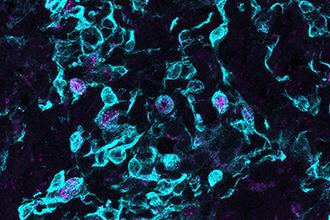New quality control revealed in immune T cell development

Microscopic view of cells in the thymus, an organ located just above the heart that trains immune T cells to defend the body against viruses and bacteria. Credit: Walter and Eliza Hall Institute, Australia
T cells are an important component of the immune system, orchestrating immune responses in reaction to infections. The thymus is like a 'school' for T cells, training them how to fight infections and eliminating the 'naughty' cells that have the potential to launch dangerous autoimmune attacks on the body's own tissues. Only a small proportion of the T cells that begin their development 'graduate' and are allowed out of the thymus, into the bloodstream – the rest do not survive.
Dr Charis Teh, Dr Daniel Gray and colleagues made the discovery, published in the journal Nature Communications, when investigating the link between faulty LUBAC and T cell defects.
Dr Teh said the team were surprised to discover that LUBAC was important for a very late stage of T cell development within the thymus.
“Since the function of the thymus was discovered by Professor Jacques Miller almost 60 years ago, there has been an intense research effort to reveal the intricate details of how immune T cells develop,” she said.
“By showing that LUBAC is essential for T cell development, we also revealed a new stage of 'T cell education' that had not previously been appreciated. We're excited by the prospect that this new checkpoint may be important for ensuring autoimmune T cells are not allowed to complete their development,” she said.
“In most people, this prevents the development of autoimmune diseases such as type 1 diabetes and multiple sclerosis,” Dr Teh said.
Dr Gray said the team hoped that by understanding the newly discovered process better, they may be able to develop new approaches to 'switch off' autoimmune T cells. “This may have therapeutic applications in the future for treating autoimmune diseases,” Dr Gray said.
“Another interesting aspect of this research relates to rare inherited immune disorders caused by defects in the genes that encode the components of LUBAC. Our research has provided new insights into how these disorders are linked to faulty T cell function. This may inspire to new immune-based therapies for these conditions,” he said.
###
The research was supported by Diabetes Australia, the National Health and Medical Research Council, Cancer Australia, the Australian Research Council, the Leukemia and Lymphoma Society (US), the Wellcome Trust (UK), and the Victorian Government Operational Infrastructure Scheme.
Media Contact
All latest news from the category: Life Sciences and Chemistry
Articles and reports from the Life Sciences and chemistry area deal with applied and basic research into modern biology, chemistry and human medicine.
Valuable information can be found on a range of life sciences fields including bacteriology, biochemistry, bionics, bioinformatics, biophysics, biotechnology, genetics, geobotany, human biology, marine biology, microbiology, molecular biology, cellular biology, zoology, bioinorganic chemistry, microchemistry and environmental chemistry.
Newest articles

Silicon Carbide Innovation Alliance to drive industrial-scale semiconductor work
Known for its ability to withstand extreme environments and high voltages, silicon carbide (SiC) is a semiconducting material made up of silicon and carbon atoms arranged into crystals that is…

New SPECT/CT technique shows impressive biomarker identification
…offers increased access for prostate cancer patients. A novel SPECT/CT acquisition method can accurately detect radiopharmaceutical biodistribution in a convenient manner for prostate cancer patients, opening the door for more…

How 3D printers can give robots a soft touch
Soft skin coverings and touch sensors have emerged as a promising feature for robots that are both safer and more intuitive for human interaction, but they are expensive and difficult…





















